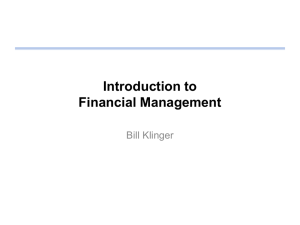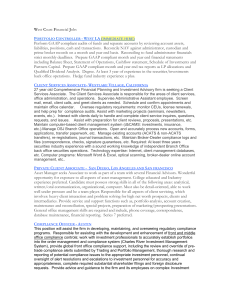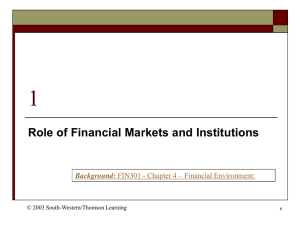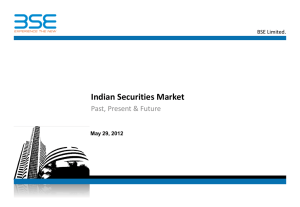Sample Integrated ALM and Investment Policy
advertisement
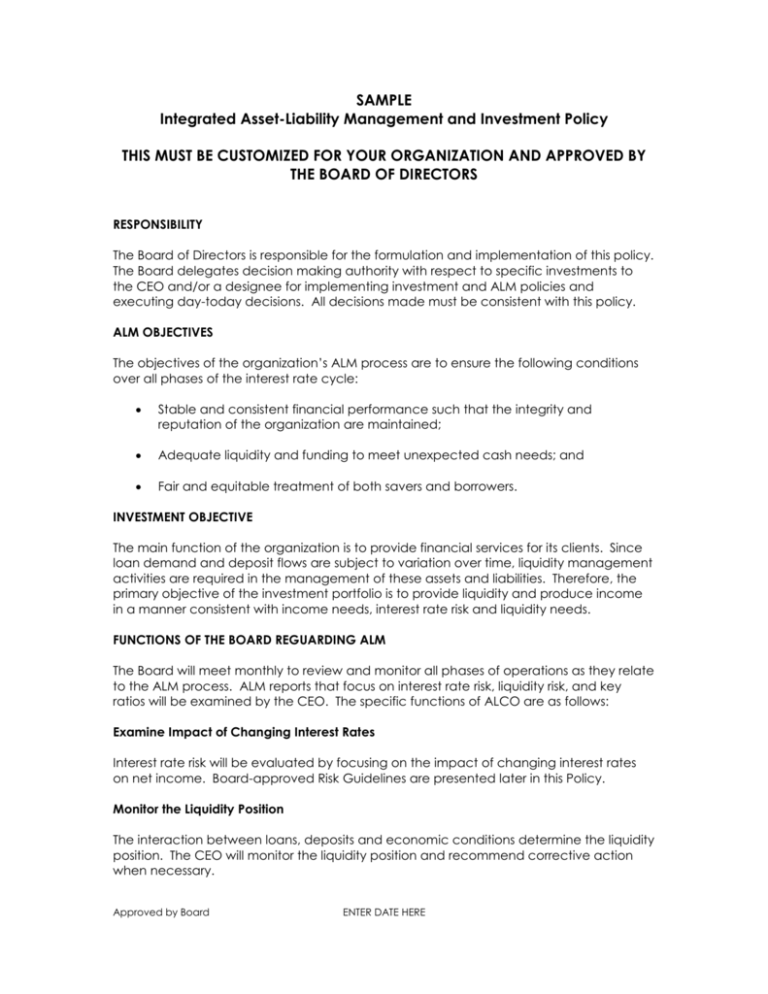
SAMPLE Integrated Asset-Liability Management and Investment Policy THIS MUST BE CUSTOMIZED FOR YOUR ORGANIZATION AND APPROVED BY THE BOARD OF DIRECTORS RESPONSIBILITY The Board of Directors is responsible for the formulation and implementation of this policy. The Board delegates decision making authority with respect to specific investments to the CEO and/or a designee for implementing investment and ALM policies and executing day-today decisions. All decisions made must be consistent with this policy. ALM OBJECTIVES The objectives of the organization’s ALM process are to ensure the following conditions over all phases of the interest rate cycle: Stable and consistent financial performance such that the integrity and reputation of the organization are maintained; Adequate liquidity and funding to meet unexpected cash needs; and Fair and equitable treatment of both savers and borrowers. INVESTMENT OBJECTIVE The main function of the organization is to provide financial services for its clients. Since loan demand and deposit flows are subject to variation over time, liquidity management activities are required in the management of these assets and liabilities. Therefore, the primary objective of the investment portfolio is to provide liquidity and produce income in a manner consistent with income needs, interest rate risk and liquidity needs. FUNCTIONS OF THE BOARD REGUARDING ALM The Board will meet monthly to review and monitor all phases of operations as they relate to the ALM process. ALM reports that focus on interest rate risk, liquidity risk, and key ratios will be examined by the CEO. The specific functions of ALCO are as follows: Examine Impact of Changing Interest Rates Interest rate risk will be evaluated by focusing on the impact of changing interest rates on net income. Board-approved Risk Guidelines are presented later in this Policy. Monitor the Liquidity Position The interaction between loans, deposits and economic conditions determine the liquidity position. The CEO will monitor the liquidity position and recommend corrective action when necessary. Approved by Board ENTER DATE HERE Liquidity Ratios to be monitored on a monthly basis are: Cash and equivalents; minimum cash balance in Money Market account to be XXX,XXXX to cover immediate potential needs. Cash and Equivalents to Total Shares Ratio to be between 5-25% Cash and Short Term Investments to Total Assets between 15- 25% Loan to Share Ratio to be between 60-90% Borrowings to Total Shares and Liabilities between 15-20% Net Long Term Assets to Total Assets must be less than 30% Monitor Key Ratios and Statistics In addition to the ratios and statistics related to interest rate risk and liquidity, the Board will monitor the key ratios that measure other aspects of operations. Review and Monitor Competitive Position The CEO will review and monitor the rates charged and paid by competing institutions for loans, shares, certificates and other savings instruments. The purpose of this review process is as follows: To ensure that the rates paid on shares and certificates and the rates charged on loans are consistent with local and national market conditions; To ensure that interest rates paid and charged are fair and equitable to both savers and borrowers; and To ensure that profitability and financial strength are not impaired by interest rate and/or dividend policies. INTEREST RATE RISK GUIDELINES AND POLICIES The nature of ALM and the dynamics of the financial statement in changing market conditions make it difficult to specify rigid policies related to interest rate risk control and liquidity management. Also, corrective action often requires Board approval for policy changes, the effects of which may take considerable time. Thus, in some sections below, the Board sets forth risk “guidelines” rather than rigid “policies.” These guidelines provide Management with operational latitude and yet specify the degree of interest rate risk that is acceptable to the Board of Directors. Forecasting Interest Rates The policy of the organization is not to forecast interest rates but to position itself such that it is not significantly affected by changes in interest rates regardless of the magnitude of the changes. Setting Dividend Rates The Money Market Account is designed to provide clients with liquidity and a yield that is related to money market conditions. Similarly, the rates on client certificates must be competitive and changed to reflect market conditions. The nature of these accounts is such that the dividend rates must be reviewed and reset weekly, if necessary. Approved by Board ENTER DATE HERE Accordingly, the Board of Directors delegates to Management the authority to set the rates on these accounts on a weekly basis and in a manner consistent with the following: Conditions in the national money markets, including the rates paid by money market mutual funds; Rates offered by local depository financial institution for similar products; Rates paid on other accounts offered by the organization, that is, the MMA rate will be higher than the share rate and lower than short-term certificate rates; and The financial condition and overall asset-liability management position and goals of the organization. Dividend Pricing Strategy This strategy is developed as a guide as how to handle savings rates in an increasing rate environment. There are many factors to be taken into account during this time; this strategy is meant to provide some guidance when interest rates are increasing. In an increasing rate environment one of the first reactions will be to increase share rates. An increase to share rates must be carefully considered because in order to keep a sufficient interest rate margin, the lending rate must also be increased. Since a change in lending rates takes longer for the effects to show and do not occur right away the process requires monitoring. A gross spread, the difference between Interest Income and Dividend Expense, to be not less than 3.5%. With our other costs and incomes remaining the same will provide us with enough income to generate net worth. In order to maintain liquidity (Loan to Share ratio of 90% or below) and our gross spread in an increasing rate environment we will increase our savings rates in conjunction with other financial institutions in the area. In order to maintain our gross spread we must at the same time or prior to any savings rate increase our lending rates to an appropriate level. ALM AND INVESTMENT POLICY When possible, the investment portfolio should be used to make adjustments in the ALM and liquidity position. Managing the maturity structure of the portfolio in an ALM context allows adjustments to be made and exert greater control over interest rate risk, liquidity risk and income. Any investments made outside of the policy must be approved by the Board of Directors prior to purchase. If the exception in found after the purchase is made, the Board will either approve the purchase, or the security will be sold immediately. REPORTING PROCEDURES Because of the Board’s role in approving policies that affect the ALM position, it is essential that the Board of Directors be kept informed of the ALM risk position. The reporting procedures outlined below will be followed: Approved by Board ENTER DATE HERE Reports to the Board At least once every calendar quarter, Management will report on the ALM position. The report should consist of the following: Changes in cash position; Cash flow actual to budget; Cash flow projections; and Liquidity ratios to policy. Policy Changes When necessary, the CEO will recommend strategies or policy changes to the Board of Directors to correct ALM-related problems. Investment Triggers and Guidelines When the loan to share ratio is below 85-90% the organization will take the following steps to increase interest income, until the loan to share goals are met. The primary focus of the organization is to provide loans and deposit instruments to our clients at competitive rates. With this in mind the following actions will be taken in the order listed with progression to the next step dependent on results obtained from the preceding step and the business outlook for the upcoming months. Increase marketing to the existing A&B paper clientele. Create a portfolio of laddered Certificates of Deposit and bullet Treasury investments (not to exceed 20% of total assets). Buy a loan participation in an increment of 1 million dollars not to exceed total investment in loan participations of any particular type (i.e. Auto loans, Mortgages, etc) of 2 million dollars, with a CAP of the Loan to Share Ratio of 90%. Develop a portfolio of laddered amortizing Treasury investments (not to exceed 20% of total assets). If Loan to Share Ratio goes over 90% : The board knowing that such fluctuations in the loan to share ratio may be seasonal and can vary monthly will consider many options including: Short Term borrowing Reducing Loan volumes for the following months Taking steps to increasing deposits Loan Sale The Board will review the Loan to Share ratio monthly and will determine appropriate action. PORTFOLIO COMPOSITION The portfolio as a whole should have the following characteristics: A low degree of default risk; Approved by Board ENTER DATE HERE A low degree of price risk resulting from changes in interest rates; A reasonably high degree of liquidity and marketability; and All investments must be in compliance with regulatory directives. These characteristics limit the types of investments that may be acquired. The yield on investments is secondary to liquidity and safety. In addition to the emphasis on liquidity and safety, regulations and/or policies of the Board of Directors further constrain investment activity. In this section, authorized investments are outlined along with certain restricted and unauthorized investments and investment-related transactions. Maturity constraints and diversification requirements are also specified. Authorized Investments The organization may invest only in securities that are specifically authorized in this section. All other investments are prohibited by regulations and/or Board policy. The following investments are legally permitted and authorized by the Board of Directors of the organization: Insured Bank and Savings Bank CDs, Credit Union Certificates. Negotiable and nonnegotiable Certificates of any domestic commercial bank, credit union and savings bank may be acquired if the deposit does not exceed XXX,XXXX and the deposit is insured by an agency of the Government. Maturity and Average Life of Investments The maturity structure and average life of investments in the portfolio are subject to the constraints, conditions and ALM considerations below. In the case of mortgage-backed securities, the average life restrictions are at the time of purchase. If subsequent market conditions cause the average life to exceed the stated limits, each security will be evaluated for possible disposition. Bonds, CDs and Notes. Management is restricted to securities that mature not later than XX years. The purpose of this restriction is to control the risk of loss, realized or unrealized, resulting from an increase in the level of interest rates. Pass-through Securities. These are straight mortgage-backed securities paying principal, prepayments and interest to one class of investors. The average life of these securities may not exceed XX years. Approved by Board ENTER DATE HERE Balloon Securities. These are securities issued by federal agencies and backed by 5- or 7year balloon mortgage loans. The average life of these securities may not exceed 5 years. Diversification Requirements To avoid an unwarranted concentration of funds in a single entity that is subject to default risk or in a particular type of security, the following limitations or procedures are imposed: Restricted and Unauthorized Transactions and Investments Regulations prohibit or limit the use of certain types of investments and investmentrelated transactions. Pursuant to these regulations and/or this policy, the following transactions or securities are either unauthorized or restricted as indicated: Futures Contracts. A futures contract is an agreement calling for a fixed-price, future delivery of standardized securities, usually Treasury and Agency issues. This is unauthorized. Forward Placement Contracts. There are two types of forward placement contracts: Standby Commitment. This calls for the sale of a security at a future date whereby the buyer of the security is required to accept delivery at the option of the seller. The use of this contract is limited to hedging the risk associated with packaging mortgage loans. Cash Forward Agreement. This is an agreement to purchase or sell a security at a future date with mandatory delivery and acceptance. This is unauthorized. Zero-Coupon Bonds. Because of their extreme degree of price volatility, bonds that bear no contractual interest are unauthorized if the maturity exceeds four years. Short Sales. This is the sale of a security that is not owned by the organization. This is a prohibited activity. Equity Securities. Common stock, preferred stock and debt securities with possible equity participation through a conversion feature or warrants are unauthorized investments. Adjusted Trades. This is a method of hiding an investment loss by selling a security at a fictitiously high price to a dealer and simultaneously buying another over-priced security from the same dealer. This is a prohibited activity. IOs and POs. Interest-only (IOs) and Principal-only (POs) are stripped mortgage-backed instruments. Because of their extreme price volatility, these securities are unauthorized. Approved by Board ENTER DATE HERE Residuals. This security is the excess cash flow from a mortgage-backed security after all other payments have been satisfied. These securities are unauthorized. When-Issued Trading. This is the purchase and sale of a security between the announcement date of the sale and the settlement date. This practice is unauthorized. Pair-Offs. A pair-off results from the purchase and sale of the same security prior to the settlement date. This is a prohibited activity. Dual-Index Bonds. The interest rate on these bonds is linked to dual-indexes such that the contractual rate can be adversely affected by a shift in both the level and structure of interest rates. These securities are unauthorized. Inverse Floaters. The interest rate on these bonds moves opposite to that of an index. These securities are prohibited. GENERAL PORTFOLIO POLICIES Trading Activity Prohibited Trading securities with the intent to profit from short-term swings in interest rates is prohibited. However, this does not mean that all securities must be held to maturity, as explained below. FASB 115 Considerations Pursuant to the Financial Accounting Standards Board Statement No. 115 (FASB 115) each investment at the time of purchase shall be classified in one of the following categories: a) Hold-to Maturity, b) Available-for-Sale, or c) a Trading account. In order for securities to be classified in the Hold-to-Maturity category, the organization must have the positive intent and ability to hold the securities to maturity. These securities will be carried at amortized cost. Securities not classified as Hold-to- Maturity or as a Trading security shall be classified as Available-for-Sale with changes in the market value reflected in a separate equity account, Accumulated Unrealized Gains/Losses on Available-for-Sale Securities. (Unrealized gains or losses on Trading securities are reflected in the Income Statement. However, trading is a prohibited activity.) The organization will classify most investments as Hold-to-Maturity. However, Management may, at its discretion, classify certain investments as Available-for-Sale for liquidity purposes. In this classification process, Management will take into consideration the organization’s investment maturity structure, liquidity position, cash flows and borrowing power. Pursuant to FASB 115, it is recognized that the sale of securities in the Hold-to-Maturity category may result in the entire portfolio being reclassified and marked-to-market. However, as stated in FASB 115 (page 4), when the remaining maturity or call date is sufficiently short such that changes in market interest rates would not have a significant effect on the fair value of the securities, the securities may be sold without tainting the entire portfolio. Accordingly, the organization reserves the right to sell securities with a remaining maturity of six months or less without tainting the portfolio. The organization also reserves the right to sell any securities regardless of the classification if there is deterioration in credit quality, or in the case of amortizing securities, if the remaining principal is uneconomical to service in terms of accounting, custody and Approved by Board ENTER DATE HERE safekeeping expenses. Corporate Central investments and insured CDs are not subject to FASB 115 requirements. Block Size Guidelines When the block size of a specific investment is too small, lower yields, higher administrative costs, and less effective execution are often the result. When the block size is too big, a large amount of funds may be concentrated in a few maturities rather than being diversified or laddered over different maturity dates, thus increasing liquidity and reinvestment risk. To minimize these problems and risks, the block size of investments with fixed maturities should be within a range of approximately .5% to 2% of the organization’s assets. Other factors influencing the specific block size are the size of the investment portfolio, attractiveness of the offering, liquidity needs, and the diversification constraint regarding bank investments set forth elsewhere in this Policy. Conflicts of Interest Organization personnel having investment authority may not receive any compensation or gratuities from an approved broker, nor may personal accounts be maintained at such brokers. Multiple Bids When possible and when appropriate, multiple offers or bids will be obtained in the purchase or sale of securities. The Board recognizes that a) multiple offers are unnecessary or not possible in syndicate offerings where the price is the same by all broker/dealers and b) multiple offers or bids are not possible in situations where the securities are offered or bid by only one firm. OTHER PROCEDURES Other procedures must be followed to protect the assets of the organization. Investment Firms Investment transactions will be conducted with securities firms that are registered with the (ENTER YOUR COUNTRY’S RULE HERE) National Association of Securities Dealers (NASD) and carry SIPC insurance. Payment, Delivery and Safekeeping With respect to payment, delivery and the safekeeping of securities, the following policies will be followed: When a central account such as a Corporate Central or bank is used for the purpose of holding and/or clearing securities, a Deliver versus Payment (DVP) account should be established with the broker-dealers. Accurate DVP instructions should be maintained in order to facilitate these transactions. When securities are bought from a particular brokerage firm and held with that firm or the firm’s clearing agent, the organization should maintain a regular cash account with the brokerage firm. Confirmation statements will verify each transaction and complete Approved by Board ENTER DATE HERE statements regarding the account will be received on a monthly basis, or quarterly if there has been no activity in the account. Regardless of their form, book-entry, physical, or held in the Depository Trust Corporation (DTC) or a similar institution, securities may be held in street name with a reputable securities or securities clearing firm. Approved Broker/Dealers, Limits and Custody/Safekeeping Agents All Broker/Dealers must be approved by the Board of Directors prior to any investments being made with them. Limits. There are no limits on the amount of funds invested or types of investments made through the individual broker/dealers. The amounts invested or types of investments made through a particular broker/dealer will be at the discretion of Management and based on product offerings, pricing, execution, market information, expertise, and/or other services provided by the individual broker/dealer. Custody/Safekeeping. The following custody/safekeeping agents are approved: Other custody/safekeeping agents may be approved by Management and ratified by the Board at a subsequent Board meeting. Agents approved in this manner may be added by means of an Addendum to this Policy. External Investment Management Funds may be managed externally by an investment advisor approved by the Board and registered with Securities and Exchange Commission (SEC) under the Investment Advisers Act of 1940. Such investment management must be in full compliance with this Policy and regulatory directives. A brief summary of the approved investments and maximum maturities may be provided to the investment advisor. Approved by Board ENTER DATE HERE EXCEPTIONS AND REVIEW The Board recognizes that minor policy exceptions may arise from time to time. Significant deviations from the Policy must be avoided. This Policy shall be reviewed periodically by Management, ALCO, and the Board of Directors and amended as circumstances warrant. Approved by the Board of Directors on (ENTER DATE). Approved by Board ENTER DATE HERE


